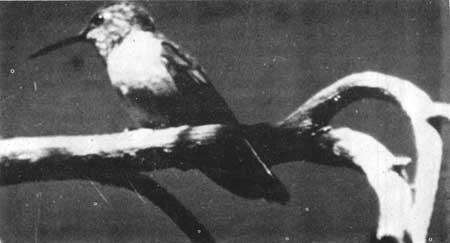|
Volume XX - 1954
Hummingbird Antics
By Edward A. Burnham, Ranger Naturalist
Just a few dozen yards below the summit of Garfield Peak I was
startled by a sudden swoosh and a shrill note as a streak went by only a
few feet in front of my head. I had just finished planting a flower
marker sign on the trail to the top of Garfield Peak. It was Monday,
August 16, at about 4:20 p.m.
I kept on hiking and once again - zoom - right in front of me
swished the small blurred object! I watched as it arched into the air,
turned and headed straight for me. This male hummingbird began a series
of plunges from 40 or 50 feet up, emitting a sharp note at the bottom of
the arc as he passed.
In early spring in Southern California I had watched and heard, on
several occasions, the courtship flight of the male Anna hummingbird. He
zooms high above the female and then darts down in an arc, making an
explosive sound directly over her. But here I was near a mountaintop in
the middle of August, very late in the season for any display of
territorial behavior, and I have yet to be told I resemble a female
hummingbird!
This kept up for about three minutes. Each zoom caused me to duck,
even though I realized that the small object was only a tiny bird headed
in my direction. Then he disappeared. I feel fairly certain that he was
a rufous hummingbird, Selasphorus rufus (Gmelin). I wonder what
he took me for?

Rufous Hummingbird
From Kodachrome by Welles &
Welles
So Many Tiny Birds
By Donald Van Tassel, Ranger Naturalist
The hillsides above Castle Crest Wildflower Gardens were covered
with many kinds of colorful flowers. One could hear the buzzing of the
busy bees. But such large bees. No, they couldn't be, they were tiny
birds - dozens of little zooming hummingbirds, flashing by like jet
airplanes and oh, so busy. Thus, I became acquainted with one of the
tiniest birds in the park and in the United States.
They proved to be the rufous hummingbird, Selasphorus rufus
(Gmelin), which is by far the most abundant hummingbird in the park, as
in all of Oregon. The dazzling copper-red gorgest flashing in the sun
and the rufous or reddish-brown back proved to be his marks of
distinction. The females and young are much more difficult to
recognize.
In addition to the beautiful iridescent coloring, I was fascinated
with their continuous activity. They must be very nervous, as they are
always on the move, seldom stopping to rest. The average camera is quite
unequal to their size and speed. When they are not darting from one
flower to the next, they are chasing each other in great frenzy.
This year I noticed that the rufous was first apparent in large
numbers about the middle of July, feeding in the blossoms of big
huckleberry, Vaccinium membranaceum, Dougl., a little above
Castle Crest Gardens. By the first of August, the young were all flying,
and the scarlet gilia, Gilia aggregate, (Pursh) Spreng., red
monkeyflower, Mimulus lewisii Pursh and columbine, Aquilegia
formosa Fisch., helped provide for the increased numbers. They seem
to prefer tubular flowers, such as those on members of the figwort
family, which their long bill is capable of penetrating. This year the
Castle Crest wild flowers were very abundant, which no doubt accounts
for the appearance of so many hummers.
I happened to have occasion to be on all of the main trails during
the first week in August. I noticed female and juvenile rufous
hummingbirds along each of them, although I seldom saw the males.
During the launch trip around the lake on the morning of August 8, a
female rufous power-dived my wife, who was wearing a bright red sweater.
It hovered only about two feet above her head before it flew off toward
the Phantom Ship, which was nearby.
The calliope hummingbird, Stellula calliope (Gould), is also
found in the park, but these birds are relatively scarce here and are
found mostly at the lower elevations. The calliope is the smallest bird
in the United States, not much larger than a large bumble bee. It is
also very colorful, the gorgest having a rayed or stripes rose-purple
effect, in contrast to the solid flame-red of the rufous.
Beautiful flowers and fascinating birds are a grand combination. I
personally invite you to take any one of our trails, around the first of
August, for this impressive treat.
References
Farner, Donald S. 1952. The Birds of Crater Lake National
Park, University of Kansas Press. xi, 187 pp.
Gabrielson, Ira N. and Stanley G. Jewett. 1940. Birds of
Oregon, Oregon State College Press, Corvallis. xxx, 650 pp.
| 
